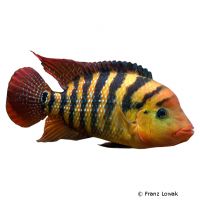Red Terror Cichlid (Mesoheros festae)
| Red Terror Cichlid Mesoheros festae | |
|---|---|
| Name | Red Terror Cichlid |
| Name Lat. | Mesoheros festae |
| Synonym | Cichlasoma festae |
| Family | Cichlids |
| Family lat. | Cichlidae |
| Order | Cichlids |
| Order lat. | Cichliformes |
| Origin | South America |
| Habitat | Rivers, tributaries |
| Diet | Omnivore |
| pH | 6.0-8.0 |
| Behavior | Aggressive |
| Keeping | Pair |
| Care Level | Difficult |
| Reproduction | Cave spawner |
| Breeding | Simple |
| Life Span | 10-12 years |
| Protection | No |
| Metric Units | |
| Size | 30-40 cm |
| Temperature | 22-26 °C |
| Hardness | 2-18 °dH |
| Aquarium | ~ 800 l |
| US Units | |
| Size | 12"-16" |
| Temperature | 72-79 °F |
| Hardness | 36-320 ppm |
| Aquarium | ~ 200 gal |
Distribution and habitat
The distribution area of the orange tiger cichlids is the catchment area of the Rio Esmaraldas in Ecuador and the Rio Tumbes in Peru. They live mostly in rivers with weak current and their tributaries, often with dense riparian vegetation and sandy muddy bottoms with roots and dead wood.
Maintenance
They need a well structured aquarium with some robust plants, with plenty of hiding places (stones, roots) and plenty of swimming space. A soft, sandy substrate covered with some foliage for digging and subdued light (floating plants) is ideal.
No ammonia, ammonium and nitrite should be detectable, the nitrate value should not exceed 100 mg/l. To ensure water quality and oxygen content, a filter and heater adapted to the aquarium size is required, as well as lighting for the species-appropriate day-night rhythm of the animals.
Diet
The food supply consists of high-quality dry food for cichlids (pellets, granules), supplemented with live or frozen food, such as artemia, mysis and red mosquito larvae or a commercially available frozen special food mix for cichlids, as well as occasionally earthworms or meal beetle larvae for adult animals. In addition, they need regular vegetable food, such as algae leaves or dry food with high vegetable content (spirulina).
Only feed as much as is eaten immediately (in a maximum of 10 minutes). Regular and varied feeding promotes health and increases resistance.
Behaviour and compatibility
They should be kept in pairs. Especially during the spawning season, they strongly defend their territory against conspecifics and other fish with similar appearance. Multiple pairs can only be kept together in a much larger and richly structured aquarium. They should only be socialized with robust fish of similar size. Fish that are too small are considered prey
Basically, only compatible fish species with similar water condition and water temperature requirements should be socialized.
Sex dimorphism
Males grow larger than females and lose their red juvenile coloration. The females retain their strong red and the transverse striation, which is only visible in males during the mating season
Reproduction and breeding
They spawn in a cave or a sheltered place. The female performs brood care, while the male defends the territory. After 3-4 days, the fry hatch and are then housed and guarded in a bottom pit prepared outside the cave until they swim free after 5-6 days. Often the school of fry is still guarded by the parents for some time.
Fry must be fed several times a day with special rearing food (e.g. Artemia nauplii). In community tanks breeding is hardly possible, because the fry are easy prey.
Important
They like to burrow, but often damage the roots of plants, so it is recommended to use potted plants.
The well-being of the fish should be checked regularly. Temperature should be checked daily, pH, hardness and nitrate levels at least every 14 days. Regular partial water changes are recommended, even if the pollutant level has not yet reached the upper limit. Sudden changes in water quality should be avoided. Newly introduced fish must be accustomed slowly to the water in the aquarium.
Further literature can be found in your pet store.
References
Text: Werner Winter; Image: Franz Lowak
Source: BMELV (1998): Tierschutzgutachten - Haltung von Zierfischen (Süßwasser); BAENSCH & RIEHL (2004): Aquarien Atlas Bd. 2, Mergus Verlag; ENGELMANN (2005): Zootierhaltung - Tiere in menschlicher Obhut: Fische, Verlag Harri Deutsch
- Gemäß § 21 Abs. 5 Tierschutzgesetz idgF
